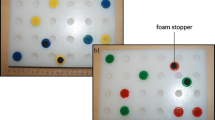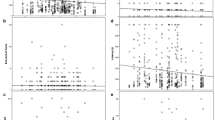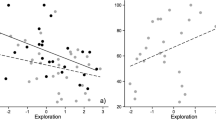Abstract
In animals, individual differences in learning ability are common and are in part explained by genetic differences, developmental conditions and by general experience. Yet, not all variations in learning are well understood. Individual differences in learning may be associated with elementary individual characteristics that are consistent across situations and over time, commonly referred to as personality or temperament. Here, we tested whether or not male great tits (Parus major) from two selection lines for fast or slow exploratory behaviour, an operational measure for avian personality, vary in their learning performance in two related consecutive tasks. In the first task, birds had to associate a colour with a reward whereas in the second task, they had to associate a new colour with a reward ignoring the previously rewarded colour. Slow explorers had shorter latencies to approach the experimental device compared with fast explorers in both tasks, but birds from the two selection lines did not differ in accomplishing the first task, that is, to associate a colour with a reward. However, in the second task, fast explorers had longer latencies to solve the trials than slow explorers. Moreover, relative to the number of trials needed to reach the learning criteria in the first task, birds from the slow selection line took more trials to associate a new colour with a reward while ignoring the previously learned association compared with birds from the fast selection line. Overall, the experiments suggest that personality in great tits is not strongly related to learning per se in such an association task, but that birds from different selection lines might express different learning strategies as birds from the different selection lines were differently affected by their previous learning performance.


Similar content being viewed by others
References
Amy M, Sprau P, De Goede P, Naguib M (2010) Effects of personality on territory defence in communication networks: a playback experiment with radio-tagged great tits. Proc R Soc Lond B 277:3685–3692
Arnold KE, Ramsay SL, Donaldson C, Adam A (2007) Parental prey selection affects risk-taking behaviour and spatial learning in avian offspring. Proc R Soc Lond B 274:2563–2569
Bates D (2005) Fitting linear mixed models in R. R News 5:27–30
Boogert NJ, Reader SM, Laland KN (2006) The relation between social rank, neophobia and individual learning in starlings. Anim Behav 72:1229–1239
Both C, Dingemanse NJ, Drent PJ, Tinbergen JM (2005) Pairs of extreme avian personalities have highest reproductive success. J Anim Ecol 74:667–674
Carere C, Welink D, Drent PJ, Koolhaas JM, Groothuis TGG (2001) Effect of social defeat in a territorial bird (Parus major) selected for different coping styles. Physiol Behav 73:427–433
Dingemanse NJ, Both C, Drent PJ, Tinbergen JM (2004) Fitness consequences of avian personalities in a fluctuating environment. Proc R Soc Lond B 271:847–852
Drent PJ, Van Oers K, Van Noordwijk AJ (2003) Realized heritability of personalities in the great tit (Parus major). Proc R Soc Lond B 270:45–51
Dugatkin LA, Alfieri MS (2003) Boldness, behavioral inhibition and learning. Ethol Ecol Evol 15:43–49
Exnerová A, Svádová KH, Fučiková E, Drent PJ, Štys P (2010) Personality matters: individual variation in reactions of naive bird predators to aposematic prey. Proc R Soc Lond B 277:723–728
Fucikova E, Drent PJ, van Oers K (2009) Handling stress as a measurement of personality in great tit nestlings (Parus major). Ethology 115:366–374
Groothuis TGG, Carere C (2005) Avian personalities: characterization and epigenesis. Neurosci Biobehav R 29:137–150
Guillette LM, Reddon AR, Hurd PL, Sturdy CB (2009) Exploration of a novel space is associated with individual differences in learning speed in black-capped chickadees, Poecile atricapillus. Behav Proc 82:265–270
Guillette LM, Reddon AR, Hoeschele M, Sturdy CB (2010) Sometimes slower is better: slow-exploring birds are more sensitive to changes in a vocal discrimination task. Proc R Soc Lond B 278:767–773
Healy SD, Bacon IE, Haggis O, Harris AP, Kelley LA (2009) Explanations for variation in cognitive ability: behavioural ecology meets comparative cognition. Behav Proc 80:288–294
Holm S (1979) A simple sequentially rejective multiple test procedure. Scand J Stat 6:65–70
Kurvers RHJM, van Oers K, Nolet BA, Jonker R, van Wieren SE, Prins HHT, Ydenburg RC (2010a) Personality predicts the use of social information. Ecol Lett 13:829–837
Kurvers RHJM, Prins HHT, van Wieren SE, van Oers K, Nolet BA, Ydenburg RC (2010b) The effect of personality on social foraging: shy barnacle geese scrounge more. Proc R Soc Lond B 277:601–608
Marchetti C, Drent PJ (2000) Individual differences in the use of social information in foraging by captive great tits. Anim Behav 60:131–140
Naguib M, Kazek A, Schaper S, van Oers K, Visser ME (2010) Singing activity reveals personality traits in great tits. Ethology 116:763–769
Naguib M, Floercke C, van Oers K (2011) Effects of social conditions during early development on stress response and personality traits in great tits (Parus major). Dev Psychobiol 53:592–600
Reader SM (2003) Innovation and social learning: individual variation and brain evolution. Anim Biol 53:147–158
Shettleworth SJ (2001) Animal cognition and animal behaviour. Anim Behav 61:277–286
Sih A, Kats LB, Maurer EF (2003) Behavioural correlations across situations and the evolution of antipredator behaviour in a sunfish-salamander system. Anim Behav 65:29–44
Sih A, Bell A, Johnson JC (2004) Behavioural syndromes: an ecological and evolutionary overview. Trends Ecol Evol 19:372–378
Sneddon LU (2003) The bold and the shy: individual differences in rainbow trout. J Fish Biol 62:971–975
Titulaer M, van Oers K, Naguib M (2012) Personality affects learning performance in difficult tasks in a sex-dependent way. Anim Behav 83:723–730
van Oers K, Mueller JC (2010) Evolutionary genomics of animal personality. Phil Trans R Soc Lond B 365:3991–4000
van Oers K, Drent PJ, de Goede P, van Noordwijk AJ (2004) Realized heritability and repeatability of risk-taking behaviour in relation to avian personalities. Proc R Soc Lond B 271:65–73
van Oers K, de Jong G, van Noordwijk AJ, Kempenaers B, Drent PJ (2005a) Contribution of genetics to the study of animal personalities: a review of case studies. Behaviour 142:1191–1212
van Oers K, Klunder M, Drent PJ (2005b) Context dependence of personalities: risk-taking behavior in a social and a nonsocial situation. Behav Ecol 16:716–723
van Oers K, Drent PJ, Dingemanse NJ, Kempenaers B (2008) Personality is associated with extra-pair paternity in great tits (Parus major). Anim Behav 76:577–584
Verbeek MEM, Drent PJ, Wiepkema PR (1994) Consistent individual differences in early exploratory behaviour of male great tits. Anim Behav 48:1113–1121
Verbeek MEM, Boon A, Drent PJ (1996) Exploration, aggressive behavior and dominance in pair-wise confrontations of juvenile male great tits. Behaviour 133:945–963
Acknowledgments
We thank Floor M. Petit and Marylou Aaldering for animal caretaking, Mieke Titulaer for discussions, and Dalila Bovet and Nancy Burley for comments on previous versions of the manuscript. We also thank the four anonymous referees for their constructive comments on the manuscript. M.A. was supported by the FYSSEN foundation. KvO was supported by an NGI-HORIZON grant.
Author information
Authors and Affiliations
Corresponding author
Rights and permissions
About this article
Cite this article
Amy, M., van Oers, K. & Naguib, M. Worms under cover: relationships between performance in learning tasks and personality in great tits (Parus major). Anim Cogn 15, 763–770 (2012). https://doi.org/10.1007/s10071-012-0500-3
Received:
Revised:
Accepted:
Published:
Issue Date:
DOI: https://doi.org/10.1007/s10071-012-0500-3




